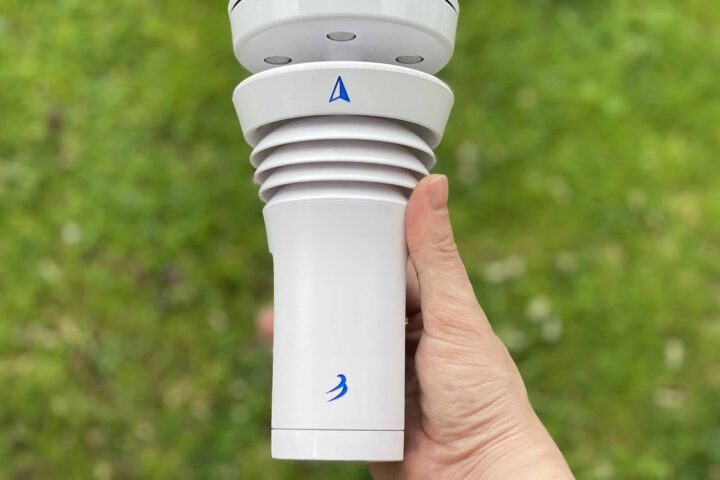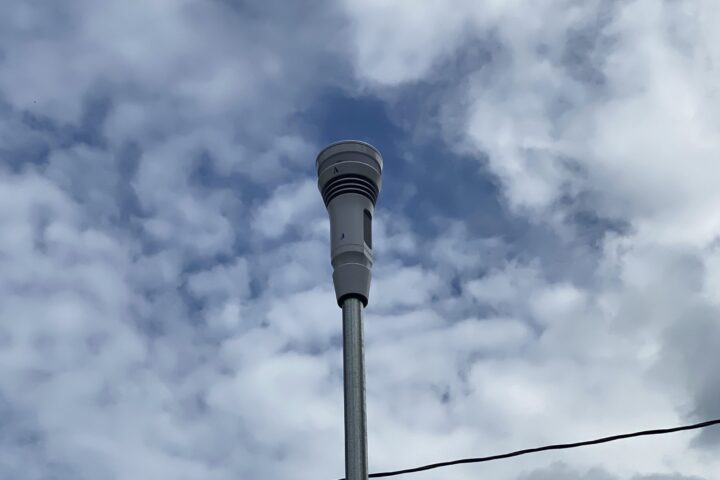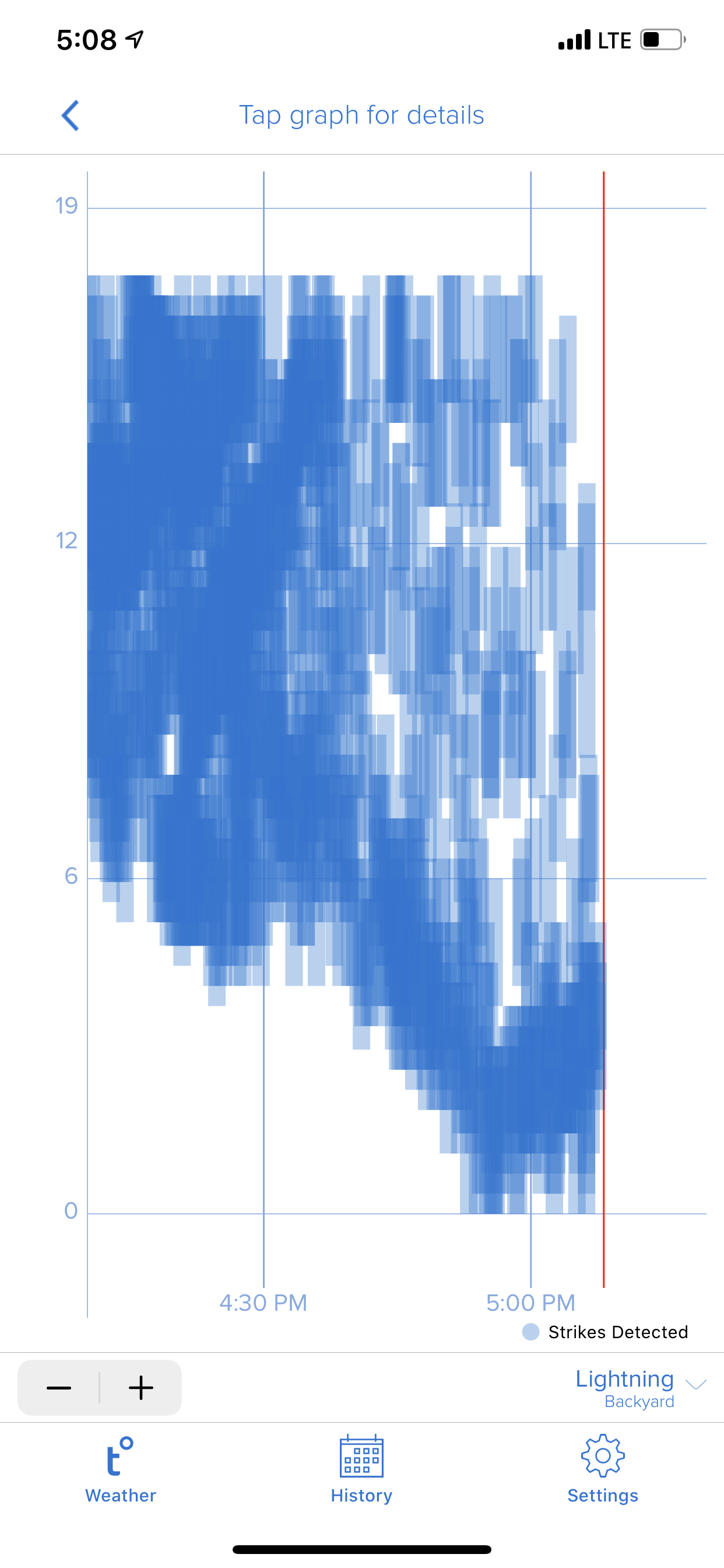- Super quick setup
- Outstanding lightning detection
- Fairly accurate instrumentation
- Ready for the smart home
- The haptic rain sensor doesn’t measure rainfall accurately enough
- No expandability
The Tempest Weather System is a weather station I’ve been watching for years. The weather station first debuted on Indiegogo in late 2016 (no, that’s not a typo) and looked like nothing else on the market.
Many weather stations are tricky to install. That is not the case here. The Tempest had everything in a small package, not much larger than a human hand. It also promised smart home connectivity, which wasn’t all that common then. Weather stations make sense for many smart home enthusiasts since smart home devices benefit from weather data.
But it’s taken several years to reach the point where the station was ready for mass production. While the original model was eventually delivered to initial backers by 2018, the Tempest wasn’t commercially available until 2020. That’s a long wait.
Much of the holdup was due to a new rainfall measurement method that WeatherFlow was working on involving haptics. Whereas most digital rain gauges use a tipping-bucket mechanism, the Tempest senses the vibrations of rain hitting the top of the sensor suite. They own a patent on this technology.
It took time to get things right. But overall, the Tempest is a station worthy of your consideration if you can deal with its quirks — which aren’t deal-breaking for everyone.
(Editor’s note: WeatherFlow spun off its weather station unit into a separate company, called Tempest. The name of the WeatherFlow Tempest is now the Tempest Weather System.)

Setting up the Tempest Weather System
We typically tell you to reserve an hour to install a weather station. Here, you may need as little as ten minutes if you have a place to mount the Tempest. You can mount it to the top of a mast or screw it onto just about anything using the tripod mount.
It’s surprisingly small and light at 7.25 inches by 7.25 inches by 12 inches and just 3.5 pounds, making the installation easy. As you can see from the picture, nearly the entire sensor fits in my hand. This compact design allows for a lot less clumsy installation — if you’ve installed a weather station before, you know the sensor suites are often bulky and hard to maneuver to install.
Since everything is pre-assembled, you place the included base station within range of your Wi-Fi router and the Tempest within range of the base station. In-app setup takes about five minutes, so your station should be up and reporting within ten minutes. We had ours live in less time than that.
Lots of functionality
The app is your console with the Tempest. Data from almost every sensor updates about every three seconds, even when you’re not on your home network (Davis’ Vantage Vue and Vantage Pro2 only do when you’re on your Wi-Fi).
The Tempest reports temperature, humidity, wind speed and direction, and rainfall, and also includes a UV and light sensor and built-in lightning detection. Thanks to haptic technology, it can also sense precipitation intensity.
Data collected by your Tempest is sent to WeatherFlow, which is used to improve the accuracy of its local forecasts. It is also shared with the National Weather Service and others as well. As expected of a smart weather station, the Tempest supports Amazon Alexa, Google Assistant, and IFTTT, and of course, you can share your weather data with Weather Underground.

Tempest Accuracy and Performance
The Tempest Weather System is a solid performer from the setup to real-world station use. Tempest says the station calibrates itself, so you won’t need to calibrate any instrumentation. We have heard from some owners that this is an issue for them — while you shouldn’t have to recalibrate, it will drift toward the end of a sensor’s usable life.
Data reports anywhere from two to 30 seconds, depending on the sensor. The instrumentation performed well compared to my Vantage Vue and a nearby NWS station.
We didn’t spot any significant issues with sensors outside the haptic rain gauge. Compared with weather stations of a similar price, it performs as well as those, if not better. The temperature and humidity readings were similar to the Davis Vantage Vue and a local NWS observing station. The sonic anemometer’s readings were also within acceptable ranges. The lightning detector is outstanding, and we’ll talk about that in the next section — it works well.
But certainly, the haptic rain sensor was my biggest concern as it is an unproven technology. Our experience was mixed. We were impressed with how quickly the Tempest Weather System knew it was raining.
In all but the lightest rain, the station was the first to detect rainfall — often within seconds. Other stations use the tipping-bucket mechanism to perform this function, and as you’d expect, notifications are significantly delayed.
This is very good for smart home uses (i.e., your sprinkler system, etc.), but unfortunately, the technology’s not quite there yet to measure rainfall.
The Tempest consistently under-measured rain, especially in heavier downpours. To correct this, WeatherFlow developed a feature called ”Rain Check.” Essentially, WeatherFlow’s systems look at the measurements from your Tempest and radar-estimated precipitation data and combine them using a proprietary formula.
The rain gauge doesn’t work, at least in its current form. Usually completed by the following morning, ”rain-checked” data would represent the best estimate of the day’s rainfall. Past all the marketing, Rain Check is an admission that the issues that bedeviled WeatherFlow engineers remain.
This is one of the station’s biggest issues and is a significant drag on our overall rating of the station. This technology doesn’t appear to be able to measure rainfall correctly. However, our test was years ago with an early unit, and we’ve heard since then, the precipitation measurements have gotten much better.

The best lightning detection we’ve seen
Now that we got the Tempest Weather System negatives behind us, let’s return to the station’s many positives. One of the standout features was lightning detection. We were lucky to have several storms pass through during the review period, giving us a great look at lightning activity, the station’s most attractive feature.
The Tempest detects lightning strikes quicker and more accurately than any other system we’ve tested. Our strike numbers appear to be close to reality compared to official lightning data. The way the app displays lightning data is also different from other apps.
Instead of displaying the number of strikes, the Tempest app plots each strike’s distance along a horizontal axis that denotes the time. The resulting graph lets you see the storm’s approach and departure, including the powerful storm that passed quite close to us during the review.
The Tempest Weather System is handy for outdoor enthusiasts with excellent lightning detection capabilities.
The Tempest Weather System is good, but
The issues with the rain sensor are a bummer. I had high hopes for it, but more work is needed. But in just about every other aspect, the Tempest Weather System exceeded our expectations. That’s not surprising, as WeatherFlow has made commercial-grade stations for years.
The smart home connectivity is super responsive, and the voice assistant integrations aren’t as long-winded as Ambient Weather. I hope that Tempest can also nail down the issues with haptics in future releases. The way they did it here doesn’t quite work, but using haptics in a weather station is a great idea. They need to figure out how to make it work better.
At $339, we expect a little better, which is why it’s lower-rated than the Davis Vantage Vue or Ambient Weather WS-5000. Those stations aren’t taking risks on new technologies that WeatherFlow is, though. If you can deal with an inaccurate rain gauge, we’d argue that this is a good buy for the lightning data alone.
Just look at the prices of lightning detectors — they’re not cheap. The WeatherFlow Tempest has placed an outstanding lightning detector inside a decent weather station. We’d recommend considering other stations first, but you might find that the Tempest meets your current needs.



I have one of the early models. Everything was working great then a couple of weeks ago the tempest dropped Wi-Fi connection. I took it down and went through the troubleshooting process, every day, multiple times a day. I guess my unit has kicked the bucket. I don’t know what I will buy to replace the tempest.
Doug – thanks for this. When we first did this review, it was brand new, but now with a few years, we’re able to get an idea of durability.
The Tempest definitely has a nice set of features that make it attractive, but you’re not the first person I’ve heard with an early unit failing. Have you reached out to support yet?
the rain sensor is able to be calibration if you have a accurate Guage you have nearby you can send rainfall amounts and have the Tempest Calibrated
Isn’t that the ‘Rain Check’ though?
Their customer service is awesome. If you call them, you almost always are speaking to an individual within two minutes.
The rain sensor is not very good I have a Davis right next to the Tempest and the Davis shows .36″ of rain and the Tempest shows .55″ .
I tried the Tempest a few years ago (3 or 4 years ago) and I agree with all of this article. For the most part the things was pin-point accurate, except for the rain gauge! I am heavily involved with Storm Chasing and Skywarn Spotting and the rain gauge was a deal-breaker for me! We had a heavy rain here one day that my Ambient Weather WS-2000 gauge clocked at 2.55″ total, my tempest said .35″ and the next day when it was sunny and beautiful it jumped up to 3.02″. I can’t have inaccuracies in the rain gauge as that is what I use to report things to the National Weather Service during my Skywarn duties, had I used the Tempest I would have looked like an idiot AND been completely wrong. NWS uses this data to distribute Watches and Warnings so it’s imperative the rain gauge be accurate, at least for my case. I know not everyone is in the same case as I am. I haven’t tried the Tempest since, and if this article was truly written a few months ago in January 2023 it seems it hasn’t improved very much in the few years I last tried it…
I’m trying to piece together how new the information in this article is, and I’m very confused how several comments appear to be a lot older than the publication date of the article. Was the article originally written well before this listed publication date? If so, you should really list that too. I’m referring specifically to the comments by the author about the problems with rain measurement and the early version tested.
Sean, thanks for the feedback, and we agree. We’re making this change across our site in the next UI refresh. This review is indeed several years old, which in most cases isn’t an issue as weather stations aren’t updated like a phone would be, etc. But I have never thought of it from this perspective, which could be most definitely confusing.
I’ve had a Tempest system for over a year now. The rain sensor is always within 10% of other manual rain gauges in close proximity. That is accurate enough for me. I did have problems with the solar power module/battery built into the system after less than a year in service. WeatherFlow customer service was outstanding and reconciled the problem with a swift replacement. Overall, great instrument for my needs.
Chuck – thanks for this. We’re likely retesting this station soon, as the test unit we had was an launch unit. From my understanding the software has been improved — especially the rainfall. We definitely weren’t 10% away in our tests, more like 20-30%, and the “Rain Check” had to fix it. I think the rainfall adjustment is called something else now, though.
I mounted my Tempest sensor on the top of a fence post for an easy first installation. This exposed another negative of the construction of the sensor head; ants colonized the entire interior e contamination of the Tempest and the contamination caused the unit to fail. A major part of the failure was loss of charging capability, the solar charging could no longer keep up with the operating load. It appeared that the ON-OFF slide switch on the bottom circuit board was a main point of the fault.
After a couple of rounds of disassembly and alcohol cleaning and re-assembly for testing, the charging capability and measurements have been restored.
The tech support phone line provided nice conversation, but no offer of any actual help with repair or replacement.
After too much handling for testing, it looks like i have damaged the FPC cable inside the very top of the sensor housing; Now the UV and Rain sensors do not report with the other data.
Try to mount your unit so that there is no path for ants to get inside, but there are numerous openings in the unit, including the obviously necessary ones for air temperature, humidity, and pressure sensing.
I have a Tempest station and pretty much agree wi what’s said in this article. But there’s no mention bof how accurate the UV measurements are. My station tends to show a much different UV level than weather apps and internet sites that give local weather. But neither of those say I’d they’re showing “projected” levels or “actual current” data